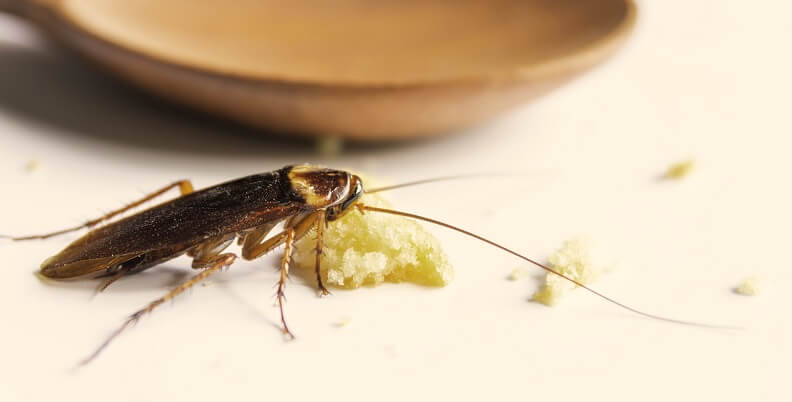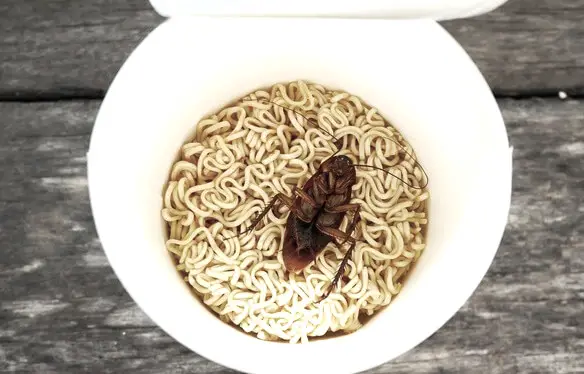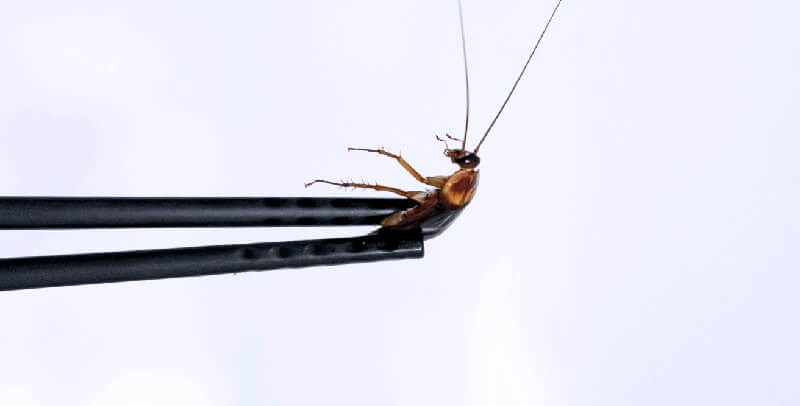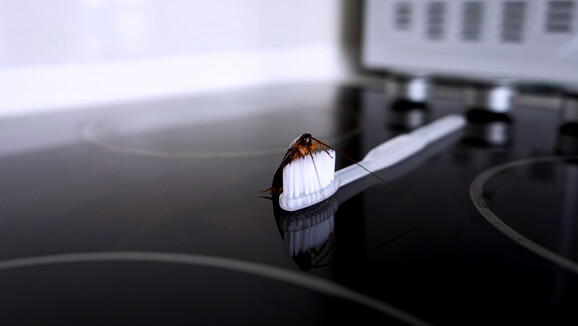What Do Cockroaches Eat?
 Cockroaches, often viewed with disgust and associated with filth, are resilient pests with an impressive diet range. Their adaptability to various environments and survival skills have cemented their place in the animal kingdom for millions of years. One major factor behind this hardiness is their broad diet. So, what do these creatures consume, and why should you be concerned?
Cockroaches, often viewed with disgust and associated with filth, are resilient pests with an impressive diet range. Their adaptability to various environments and survival skills have cemented their place in the animal kingdom for millions of years. One major factor behind this hardiness is their broad diet. So, what do these creatures consume, and why should you be concerned?
Cockroach Dietary Preferences
Cockroaches are omnivores, meaning they eat both plant and animal matter. They aren’t picky eaters and can thrive on a diet that is inedible or even harmful to many other organisms. Notably, they have a penchant for consuming nearly everything humans eat – from your favorite snacks to the grease that drips from a pan.
Human Foods in the Cockroach Diet
Many homeowners find roaches in their kitchens for a reason – these pests strongly prefer human food. Some of their favorites include:
- Greasy Foods: Be it fried chicken or buttered popcorn; if it’s oily, roaches want it.
- Starches: Breads, cereals, and pastas are staples in a cockroach diet.
- Sweets: Sugar is a magnet for these pests. From candy to spilled soda, they’ll be attracted.
- Meat Products: Proteins from animal sources are also consumed eagerly.
- Alcoholic Beverages: Astonishingly, beer can lure roaches, making it an effective trap ingredient.

Common Feeding Grounds in Homes
Roaches exploit every possible food source, often venturing into places you wouldn’t expect:
- Kitchen Surfaces: Your countertops and sinks often contain food particles. Spills around stove burners or some leftover rice grains can be a feast.
- Pantries: Items stored in paper or cardboard are particularly vulnerable. Once a cockroach breaches a food package, it’s best to discard it given the contaminants they carry.
- Floors: Crumbs that fall on the floor, especially in carpets, are prime targets.
- Pet Bowls: Leftover pet food, or even the residual crumbs, provide an abundant food source.
Beyond the Edible
While human foods form a significant portion of their diet, cockroaches venture beyond the usual:
- Paper Products: Their ability to digest cellulose means newspapers, books, and cardboard are all fair game.
- Natural Matter: Outdoor cockroach species feed on decomposing leaves, wood, and other organic detritus.
- Human Detritus: Shed skin, hair, and nail clippings are on the menu too.
- Other Cockroaches: Surprisingly, when food is scarce, roaches may resort to cannibalism.
 Why Roaches Eat What They Eat
Why Roaches Eat What They Eat
Two key factors allow roaches to consume such a varied diet: bacteria and genetics.
Cockroaches house specific bacteria in their guts. This symbiotic relationship means the bacteria get a habitat, and in return, they aid digestion and nutrient extraction from challenging foods.
Moreover, studies on cockroach genomes reveal that they have a vast arsenal dedicated to detoxifying harmful substances. This evolutionary adaptation means they can thrive in environments where other creatures might perish.
Do roaches eat roaches?
Certain species of cockroaches, such as the Oriental and German cockroach, engage in cannibalistic behavior. They can consume the deceased of their kind, and without other food sources, they might even devour their eggs and younger kin. Moreover, female American cockroaches sometimes consume their mates.
Will cockroaches eat clothes?
Cockroaches are opportunistic eaters, and while their primary diet doesn’t consist of fabric, they may chew on clothes, especially if they’re dirty. The clothing can trap skin flakes and food crumbs, which are tempting morsels for roaches. Persistent infestation could lead to fabric damage.
Do cockroaches eat dog food?
Absolutely. Cockroaches are attracted to various food types, and dog food is no exception. They can easily feed on dog food pellets left exposed, making it crucial to store such foods properly.
Do cockroaches eat cat food?
Yes, cockroaches display no preference between cat and dog food. Whether the cat food is moist or dry, roaches can feast on it. They are covering cat food when not in use is advisable to deter these pests.
Do cockroaches eat hair?
Cockroaches are scavengers and won’t hesitate to consume hair from hairbrushes, drains, or fallen strands. They can also target other bodily hair, such as eyelashes and shaving stubble.
Do cockroaches eat paper?
Absolutely. Cockroaches have a notorious reputation for consuming various paper products, including newspapers, receipts, cardboard, and even photographs, making them quite the nuisance.
Do cockroaches eat feces?
Indeed, feces, regardless of its source—be it from dogs, cats, or rodents—is a nutritious feast for cockroaches, reinforcing their scavenger nature.
Can cockroaches eat wood?
While cockroaches aren’t wood-eaters like termites, they can feed on decaying wooden matter, like dead trees and rotting wood.
Do cockroaches eat grass?
As grass begins to decay, it becomes a viable food source for certain cockroach species, which might even reside within grass clippings.
Do roaches like spicy food?
Cockroaches are not known to have a specific preference for spicy food. They’ll consume spicy residues as readily as they would any other food.
Do roaches like sugar?
Certainly. Roaches are drawn to sugar and sugary foods. While some might avoid glucose, this is not a widespread behavior.
Can cockroaches get into sealed food?
Regrettably, yes. Cockroaches can chew through various packaging materials, including paper and thin plastics. However, they can’t penetrate sealed glass containers or thick-walled plastic containers.
Do cockroaches eat fruit?
Yes, especially if the fruit is decaying. Discarded fruit and peels can attract these pests, emphasizing the importance of proper waste management.
Do roaches eat coffee grounds?
Cockroaches don’t shy away from coffee grounds. If spilled, cleaning them up is crucial to avoid attracting these insects.
Do roaches eat onions?
Cockroaches can and will consume onions, so it’s not an effective deterrent against them.
Do roaches eat bed bugs?
Being opportunistic, cockroaches will eat creatures like bed bugs that are slow-moving and easy to capture.
Do roaches eat ants?
Cockroaches are not known to prey on living ants, but they’ll consume dead ants when they encounter them.
Do cockroaches eat fleas?
While cockroaches may consume dead fleas, they typically won’t seek out live ones for food.
Do cockroaches eat salt?
Pure salt isn’t attractive to cockroaches due to its lack of nutrition. However, salty foods are a different story and can be consumed by roaches.
Do roaches eat toothpaste?
Yes, cockroaches can consume toothpaste and any food particles found within it, emphasizing the need for cleanliness.
Do roaches eat baking soda?
While roaches aren’t particularly attracted to baking soda, they might consume it if it’s mixed with appealing substances like sugar.
Do roaches eat soap?
Soap, being organic in nature, can be consumed by cockroaches, showcasing their diverse diet.
Do roaches eat plants?
Although cockroaches can consume plants, they prefer dead and decaying vegetation over fresh plants.
Can cockroaches eat through walls?
Cockroaches can’t chew through walls but can exploit small cracks and crevices to navigate through them.
Do roaches eat spray foam insulation?
While roaches don’t consume spray foam insulation for sustenance, they might burrow through it, especially if other attractive residues are present.
Do roaches eat wires?
ockroaches don’t feed on the metal of wires. Still, the insulation surrounding electrical wiring, often made of organic materials like paper or cellulose, can be consumed, potentially leading to electrical issues.
Conclusion
Understanding the cockroach’s diet underscores their adaptability and resilience. They eat various foods, from the edible to the downright revolting, owing to their symbiotic relationships and genetic makeup.
However, for homeowners, the expansive diet of cockroaches emphasizes the need for impeccable cleanliness.
Denying them food is crucial in controlling their proliferation. This means regular cleaning, storing food in airtight containers, and addressing spills immediately. With careful prevention, you can ensure your home remains an unwelcoming place for these adaptable pests.

James E. Butkovich, Pest control maven with a knack for eco-friendly & Chemical solutions. Blogger with a mission to make homes pest-free, one post at a time.
